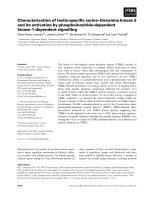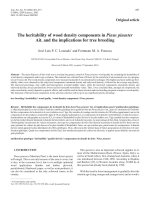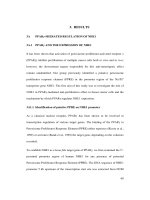THE MECHANISM OF PPARN3 MEDIATED DOWN REGULATION OF SODIUM HYDROGEN EXCHANGER 1 (NHE1) GENE EPXRESSION AND ITS INHIBITION BY ESTROGEN RECEPTOR n1 1
Bạn đang xem bản rút gọn của tài liệu. Xem và tải ngay bản đầy đủ của tài liệu tại đây (2.63 MB, 89 trang )
i
THE MECHANISM OF PPARγ-MEDIATED DOWN-
REGULATION OF SODIUM HYDROGEN EXCHANGER 1
(NHE1) GENE EXPRESSION AND ITS INHIBITION BY
ESTROGEN RECEPTOR α
Zhou Ting
(BSc. (Hons.), NUS)
A THESIS SUBMITTED
FOR THE DEGREE OF DOCTOR OF PHILOSOPHY
NUS GRADUATE SCHOOL FOR INTEGRATIVE
SCIENCES AND ENGINEERING
NATIONAL UNIVERSITY OF SINGAPORE
2012
ii
iii
ACKNOWLEDGEMENTS
I wish to express my heartfelt gratitude for my supervisor Professor Shazib
Pervaiz. I want to thank him for taking me as an honours student during
undergraduate years, and allowing me to continue my graduate study in this
lab. I am grateful for all the guidance and encouragement that he has offered
during all these years.
To Dr. Alan Prem Kumar, thank you for giving me the initial guidance when I
first entered the field of research, and throughout the course of my study. Your
advice and help will always be remembered.
I would also like to thank my TAC members, Prof Marie-Veronique Clement
and Prof Edison Liu for there invaluable input into this project. To Marie,
thank for your constructive comments during all the meeting sessions. I am
also grateful for the opportunity Prof Liu offered to let me do some of the
crucial experiments in his lab and for all the resources he provided.
My warmest thanks to all the colleagues I have worked with and learned from
throughout all these years. Special thanks to Ms Kong Say Li for teaching me
the ChIP techniques, and Ms Quak Ai Li for helping me establish the initial
direction of the project. To NUMI girls and Team Xtream, thank you for
making my PhD years enjoyable and for being great friends.
Finally, I would express my deepest gratitude for my parents. Though you are
not physically with me during all these years in Singapore, your
encouragement and support has always been the source of my strength at
every step of my endeavors.
iv
TABLE OF CONTENTS
ACKNOWLEDGEMENTS II
SUMMARY X
LIST OF FIGURES XII
LIST OF TABLES XV
LIST OF ABBREVIATIONS XVI
LIST OF PUBLICATIONS XXII
1. INTRODUCTION 1
1.1 PEROXISOME PROLIFERATOR-ACTIVATED RECEPTORS
(PPARS) 1
1.1.1 Identification of PPARs 1
1.1.2 Structural domains of PPARs 2
1.1.3 Mechanism of action of PPARs 3
1.1.4 Subtypes of PPARs 5
1.1.5 Ligands and physiological functions of PPARα and PPARδ 7
1.1.6 Ligands of PPARγ 8
1.1.7 PPARγ and adipogenesis 10
1.1.8 PPARγ and insulin sensitization 12
1.1.9 PPARs and cancer 13
1.1.10 PPARγ and breast cancer 15
1.2 ESTROGEN RECEPTORS (ERS) 18
1.2.1 Identification and structures of ERs 18
1.2.2 Mechanism of action of ERs 20
1.2.3 Estrogen and ERs in human breast cancer 23
1.2.4 Ligands of ERs 26
1.2.5 ERs cross talk with each other and with other signaling
pathways… 29
1.3 SODIUM-HYDROGEN EXCHANGER 1 (NHE1) 32
v
1.3.1 Intracellular pH regulation 32
1.3.2 Mammalian Na
+
/H
+
exchanger 32
1.3.3 NHE1 and cell volume 34
1.3.4 NHE1 and cell proliferation and differentiation 34
1.3.5 NHE1 and cell migration 35
1.3.6 NHE1 and heart disease 35
1.3.7 NHE1 and cancer 36
1.3.8 Regulation of NHE1 activity 39
1.3.9 Regulation of NHE1 transcription 41
1.4 REACTIVE OXYGEN/NITROGEN SPECIES (ROS/RNS) 43
1.4.1 ROS/RNS species 43
1.4.2 Intracellular sites of ROS production 43
1.4.3 NO production and its derivatives 45
1.4.4 The antioxidant system 47
1.4.5 ROS/RNS-mediated cell death 48
1.5 AIM OF STUDY 49
2. MATERIALS AND METHODS 51
2.1 MATERIALS 51
2.1.1 Chemicals and reagents 51
2.1.2 Cell lines and cell culture 52
2.1.3 Antibodies 53
2.1.4 Plasmids and siRNAs 54
2.1.5 Primers and Oligonucleotides 55
2.2 METHODS 56
2.2.1 Crystal violet cell viability assay 56
2.2.2 Colony forming assays 57
2.2.3 Immunofluorescence 57
2.2.4 Western Blot analysis 58
vi
2.2.5 Nuclear-cytoplasmic fractionation 59
2.2.6 Reverse Transcription-Polymerase Chain Reaction (RT-PCR) 60
2.2.7 Transient Transfection 61
2.2.8 Luciferase gene reporter assay 61
2.2.9 Chloramphenicol Acetyl Transferase (CAT) assays 62
2.2.10 Measurement of Reactive Oxygen Species (ROS) 62
2.2.11 Noshift Transcription Factor Assay 63
2.2.12 Chromatin immunoprecipitation assay 63
2.2.13 Coimmunoprecipitation 65
2.2.14 Morphology studies 66
2.2.15 Protein determination 66
2.2.16 Statistical analysis 66
3. RESULTS 68
3A PPARγ-MEDIATED REGULATION OF NHE1 68
3A.1 PPARγ AND THE EXPRESSION OF NHE1 68
3A1.1 Identification of putative PPRE on NHE1 promoter 68
3A1.2 Down-regulation of NHE1 by PPARγ ligands. 73
3A1.3 Down-regulation of NHE1 by PPARγ ligands is PPARγ-
dependent… 80
3A1.4 Silencing PPARγ abrogates the effect of PPARγ ligand on
NHE1……. 82
3A1.5 Pharmacologcial PPARγ antagonist abrogates the effect of
PPARγ ligand on NHE1 gene expression. 84
3A.2 THE MECHANISM OF PPARγ-MEDIATED DOWN-
REGULATION OF NHE1 88
3A2.1 Transcription-defective PPARγ abrogates the effect of PPARγ
ligand on NHE1 gene expression. 88
3A2.2 Activated PPARγ binds to the identified PPRE on NHE1
promoter…. 92
vii
3A.3 THE MECHANISM OF ROS/RNS-MEDIATED DOWN-
REGULATION OF NHE1 95
3A3.1 Production of ROS/RNS by PPARγ ligands in breast cancer
cells………. 96
3A3.2 ONOO
–
is the main RNS species produced by PPARγ ligands
in breast cancer cells. 97
3A3.3 ONOO
–
is partially responsible for PPARγ ligand-mediated
down-regulation of NHE1 expression 102
3A.4 THE ANTI-TUMOR EFFECTS OF PPARγ LIGANDS 109
3A4.1 PPARγ ligands induce loss of cell viability in breast cancer
cells……… 109
3A4.2 PPARγ ligands inhibit colony formation by breast cancer cells. 111
3A4.3 Anti-tumor effect of 15d-PGJ
2
is PPARγ-dependent. 114
3A4.4 Anti-tumor effects of 15d-PGJ2 is partially ROS/RNS-
dependent 119
3A4.5 Reduced NHE1 expression is responsible for PPARγ-mediated
anti-tumor effects 119
3B EFFECT OF ERα ON PPARγ-MEDIATED TRANSCRIPTIONAL
REGULATION 121
3B.1 ESTROGEN BLOCKS THE EFFECT OF PPARγ ON NHE1 121
3B1.1 Regular serum versus dextran stripped serum condition. 121
3B1.2 Estrogen blocks PPARγ-mediated down-regulation of NHE1 in
CS serum condition. 126
3B.2 ACTIVE ERα BLOCKS EFFECT OF PPARγ ON NHE1 129
3B2.1 Re-expression of ERα in ER negative MDA-MB-231 cells
restores its response to E2 on inhibiting PPARγ-mediated down-regulation
of NHE1…. 129
3B2.2 Transient silencing of ERα in ER positive MCF-7 cells
abrogates the inhibitory effect of E2 on PPARγ-mediated down-regulation
of NHE1…. 133
viii
3B2.3 Depletion of active ERα in ER positive MCF-7 cells enhances
PPARγ-mediated down-regulation of NHE1. 136
3B2.4 Re-expression of ERα in ER negative MDA-MB-231 cells
blocks PPARγ-mediated down-regulationof NHE1. 141
3B.3 TRANSCRIPTIONALLY ACTIVE ERα BLOCKS THE EFFECT
OF PPARγ ON NHE1 EXPRESSION 145
3B3.1 ERα antagonist enhances the PPARγ-mediated NHE1
repression… 145
3B3.2 ERα defective in DNA binding enhances the effect of PPARγ
ligand on NHE1 down-regulation. 149
3B.4 THE MECHANISM BY WHICH ERα BLOCKS THE EFFECT
OF PPARγ ON NHE1 EXPRESSION 153
3B4.1 ERα does not bind to the putative ERE on NHE1 promoter. 153
3B4.2 ERα suppresses binding of PPARγ to NHE1 promoter. 155
3B4.3 ERα inhibits transactivation of PPARγ 159
3B4.4 PPARγ inhibits binding of activated ERα to ERE 162
3B4.5 PPARγ physically interacts with ERα 163
3B4.6 Growth inhibitory effect by PPARγ ligand combined with ERα
antagonists. 167
4. DISCUSSION 169
4.1 ESTABLISHING THE RELATIONSHIP BETWEEN PPARγ
ACTIVATION AND NHE1 EXPRESSION 169
4.1.1 Identification of NHE1 gene as a transcriptional target of
PPARγ……. 169
4.1.2 The mechanism of PPARγ-mediated repression of NHE1 gene. 171
4.1.3 Production of ROS/RNS by PPARγ ligands in breast cancer
cells………… 174
4.1.4 The mechanism of ROS/RNS-mediated repression of NHE1
gene………. 177
4.2 ANTI-CANCER EFFECTS OF PPARγ LIGANDS 179
4.2.1 PPARγ-dependent anti-cancer effects of PPARγ agonists. 179
ix
4.2.2 PPARγ-independent anti-cancer effects of PPARγ agonists. 182
4.2.3 Repression of NHE1 is involved in anti-tumor effect of PPARγ
ligand…… 186
4.3 MECHANISM OF HOW ERα INHIBITS PPARγ-MEDIATED
DOWN-REGULATION OF NHE1 189
4.3.1 ERα negatively interferes with PPARγ-mediated down-
regulation of NHE1 gene expression. 189
4.3.2 Unravelling the mechanism of how ERα inhibits PPARγ-
mediated down-regulation of NHE1 gene expression. 192
4.3.3 Signal cross talk between ERα and PPARγ in breast cancer
cells………. 195
4.4 CLINICAL SIGNIFICANCE OF PPARγ-MEDIATED BREAST
CANCER THERAPY AND ITS POSSIBLE MODULATION BY
ER SIGNALLING PATHWAY 199
4.5 CONCLUSION 201
REFERENCES 205
x
SUMMARY
In addition to its role in lipid and glucose metabolism, peroxisome proliferator-
activated receptor gamma (PPAR) has been associated with the process of
carcinogenesis, which therefore presents a promising target for cancer treatment.
Having identified a Peroxisome Proliferator Response Element (PPRE) in the
promoter region of the pH regulator, Na+/H+ exchanger 1 (NHE1), we recently
showed that exposure of ER-negative breast cancer cells to PPAR ligands
repressed NHE1 expression, which could be inhibited by the PPAR antagonist,
GW9662. Moreover, inhibition of NHE1 expression either by direct silencing or pre-
incubation with PPAR ligands in breast cancer cells increased their sensitivity to
doxorubicin and paclitaxel. However, recent evidence of cross talks between nuclear
receptors including PPAR and the estrogen receptor (ER) pathways has been
demonstrated. Here we investigated the effect of PPAR activation on NHE1 gene
repression in the presence of 17-estradiol (E2) using ER-positive MCF-7 breast
cancer cells. Results show that E2 prevented the strong inhibition of NHE1
expression by PPAR ligands (natural or synthetic). On the contrary, E
2
was unable to
prevent the inhibition of NHE1 expression by PPAR ligands in the ER -negative
breast cancer cell line, MDA-MB-231 or in MCF-7 cells where ER was silenced by
specific ER siRNA. This result suggested that a functional activated ER is
necessary to prevent PPAR-dependent down-regulation of NHE1 by E2. Indeed, a
putative ER binding site (ERE) in close proximity and upstream of the PPRE was
identified; however, ER did not bind to the putative ERE. ER was found to
physically associate with PPAR at the PPRE and functionally interfered with PPAR
binding efficiency to NHE1 promoter. Disruption of ER-PPAR complex by anti-
estrogens led to increased efficacy of the anti-tumor activity of PPAR and its
repressive effect on NHE1 gene expression in vivo, which could be a potential
xi
combination therapy for enhanced efficacy of anti-estrogen therapy in breast cancer
patients.
xii
LIST OF FIGURES
Figures
INTRODUCTION
Figure A: Chemical structures of PPARγ agonists and antagonist.
Figure B: Chemical structures of ER agonist and antagonists.
RESULTS
Figure 1: Sequence Analysis of NHE1 Promoter.
Figure 2: PPARγ ligands down-regulate NHE1 protein levels in human
breast cancer cells.
Figure 3: PPARγ ligands down-regulate NHE1 mRNA levels in human
breast cancer cells.
Figure 4: Overexpression of PPARγ enhances the inhibition of 15d-PGJ
2
on NHE1 expressions.
Figure 5: Silencing PPARγ attenuates the inhibition of 15d-PGJ
2
on
NHE1 expression.
Figure 6: PPARγ inhibitor abrogates the effects of 15d-PGJ
2
on PPARγ
activity and on NHE1 expression.
Figure 7: Transcription-defective PPARγ abrogates the effect of PPARγ
ligand on NHE1 gene expression.
Figure 8: PPARγ binds to NHE1 promoter upon 15d-PGJ
2
treatment.
Figure 9: PPARγ ligands produce ROS/RNS in breast cancer cells.
Figure 10: PPARγ ligands produce ONOO
-
in breast cancer cells.
Figure 11: ROS/RNS contributes to down-regulation of NHE1.
Figure 12: ROS/RNS is partially responsible for 15d-PGJ
2
-mediated
down-regulation of NHE1.
xiii
Figure 13: Effects of PPARγ ligands on breast cancer cell morphology and
cell viability.
Figure 14: PPARγ agonists reduce colony-forming ability of breast cancer
cells.
Figure 15: PPARγ antagonist rescues the loss of cologenic ability induced
by PPARγ ligand in breast cancer cells.
Figure 16: FeTPPS rescues the loss of cell viability and colonogenic
ability induced by PPARγ ligand in breast cancer cells.
Figure 17: Regular serum versus charcoal/dextran-treated serum.
Figure 18: Estrogen blocks PPARγ-mediated down-regulation of NHE1
expression.
Figure 29: Re-expression of ERα blocks PPARγ-mediated down-
regulation of NHE1 expression in MDA-MB-231 cells.
Figure 20: Silencing ERα attenuates the inhibitory effect of E2 on PPARγ-
mediated down-regulation of NHE1.
Figure 21: Reduced ERα level enhances PPARγ-mediated down-
regulation of NHE1 in regular serum condition.
Figure 22: Re-expression of ERα blocks PPARγ-mediated down-
regulation of NHE1 in MDA-MB-231 cells kept in regular
serum condition.
Figure 23: ERα antagonists enhance PPARγ-mediated down-regulation of
NHE1 in regular serum condition.
Figure 24: Transfection of DNA-binding defective ERα enhances PPARγ-
mediated down-regulation of NHE1 in regular serum condition.
Figure 25: Identification of putative ERE on NHE1 promoter.
Figure 26: Binding of PPARγ to PPRE is blocked in the presence of
estrogen.
Figure 27: Transcriptional activity of PPARγ is blocked in the presence of
estrogen.
Figure 28: Binding of ERα to ERE is blocked in the presence of PPARγ
ligand.
Figure 29: Physical interaction between PPARγ and ERα.
Figure 30: ERα antagonists enhanced the effect of PPARγ ligand on
colony-forming ability in MCF-7 cells.
xiv
Figure 31: The mechanism of PPARγ-mediated down-regulation of NHE1
and its inhibiton by ERα.
xv
LIST OF TABLES
Tables
RESULTS
Table 1: PPRE sequences from literature
xvi
LIST OF ABBREVIATIONS
15d-PGJ
2
15-Deoxy-Delta-12, 14-protaglandin J2
AA Arachidonic acid
ACO Acyl-CoA oxidase gene
AF Activation function
AluRRE Alu Receptor Response Element
AP-1 Activatior protein 1
aP2 Adipocyte protein 2
ATP 2-adenosine 5’-triphosphate
Bak Bcl-2 antagonist/killer
Bax Bcl-2 associated X protein
Bcl-2 B-cell lymphoma protein 2
BME Beta-mercaptoethanol
bp Base pair
BSA Bovine serum albumin
Caspase Cysteine-dependent aspartate-specific protease
CAII Carbonic anhydrase II
CaM Calmodulin
CAT Chloramphenicol acetyl transferase
CBP/p400 CREB-binding protein/E1 A binding protein
P400
CDK2 Cyclin dependent kinase
cDNA Complementary DNA
ChIP Chromatin Immunoprecipitation
Cig Ciglitazone
CM-H
2
DCFDA 5-(and-6)-chloromethyl-2’,7’-dichlorofluorescin
diacetate-dichlorofluorescein diacetate
COX Cyclooxygenase
COMT Catehol O-methyltransferase
xvii
Cosi siRNA control
COUP-TF Chicken ovalbumin upstream promoter-
transcription factor
CS Charcoal-stripped
Cu/Zn SOD Copper/zinc superoxide dismutase
DAF-FM 4-Amino-5-Methylamino-2',7'-
Difluorofluorescein Diacetate
DBD DNA binding domain
DED Death effector domain
DMEM Dulbecco’s Modified Eagle’s Medium
DMSO Dimethyl sulfoxide
DNA Deoxyribonucleic Acid
DR Direct repeat
DRIP/TRAP VDR-interacting proteins/TR-interacting
proteins
DTT Dithiothreitol
E2 Estradiol
EDTA Ethylenediaminetetraacetic acid
EFR-1 Early growth response-1
EGF Epidermal growth factor
ER Estrogen receptor
ERE Estrogen response element
ERK Extracellular regulated kinase
ETC Electron transport chain
FACs Fluorescence activated cell sorter
FATP Fatty acid transport protein
FBS Fetal bovine serum
FeTPPS 5,10,15,20-Tetrakis(4-
sulfonatophenul)porpyrinato Iron(III), Chloride
GAPDH Glyceraldehyde-3-phosphate dehydrogenase
GFP Green fluorescent protein
xviii
GSH Glutathione
GSSG Glutathione disulfide
Gpx Glutathione peroxidase
H
2
O
2
Hydrogen peroxide
HDAC Histone deacetylase
HEPES 4-(2-hydroyethyl)-1-piperazineethanesulfonic
acid
HER-2 Human epidermal growth factor receptor 2
HIF Hypoxia-inducible factor
HMG-CoA 3-hydroxy-3-methyl-glutaryl-CoA
IRS Insulin receptor substrate
JNK c-Jun N-terminal kinase
kb Kilo base pair
LBD Ligand binding domain
L-NMMA L-NG-monomethyl Arginine citrate
LPL Lipoprotein lipase
MAPK Mitogen activated protein kinase
ME Malic enzyme
MAPKKK Mitogen activated protein kinase kinase kinase
MBC Methyl-beta-cyclodextrin
MEK Meiosis-specific serine/threonine protein kinase
MKP MAPK phosphatase
MnSOD Manganese superoxide dismutase
MOMP Mitochondrial outer membrane permeabilization
MPO Myeloperoxidase
MPT Mitochondrial Permeability Transition
MTT 3-(4,5-dimethylthiazol- 2-yl)-2,5
diphenyltetrazolium bromide
MYC v-myc myelocytomatosis viral oncogene
homolog
xix
NAC N-Acetyl cysteine
NCoR Nuclear receptor corepressor
NFкB Nuclear factor of kappa light
NHE Na
+
/H
+
exchanger
NO
•
Nitric oxide
NOS Nitric oxide synthase
Nox NADPH oxidase
NR Nuclear receptor
O
2
•
ˉ Superoxide radical
O-GlcNAc O linked N-acetylglucosamine
OH
•
Hydroxyl radical
ONOO
-
Peroxynitrite
PARP Poly(ADP-ribose) polymerase
PBS Phosphate buffered saline
PEPCK Phosphoenolpyruvate carboxy kinase
pHi Intracellular pH
PI Propidium iodide
PI3K Phosphatidylinositol-3-kinase
PIP2 Phosphatidylinositol diphosphate
PIP3 Phosphatidylinositol triphosphate
PKA Protein kinase A
PKB Protein kinase B
PKC Protein kinase C
PMSF Phenylmethylsuphonyl fluoride
PP Peroxisome proliferators
PP1 Phosphatase protein phosphatase 1
PP2A Protein phosphatase 2A
PPAR Peroxisome proliferator-activated receptor
PPRE Peroxisome proliferator response element
xx
PR Progesterone receptor
Prx Peroxiredoxins
PTEN Phosphatase and tensin homolog located on
chromosome ten
RAR-1 Retinoic acid receptor α-1
RNA Ribonucleic acid
RNase Ribonuclease
RNS Reactive nitrogen species
ROCK1 Rho-associated kinase 1
ROS Reactive oxygen species
RPMI 1640 Rosewell Park Memorial Institute 1640
RT-PCR Reverse transcription-polymerase chain reaction
RXR Retinoid X receptor
SDS Sodium dodecyl sulphate
SDS-PAGE SDS-polyacrylamide gel electrophoresis
Ser Serine
SERM Selective estrogen receptor modulators
shRNA Short-hairpin RNA
siRNA small interfering RNA
SMRT Silencing mediator for retinoid and thyroid
hormone receptor
SOD Superoxide dismutase
Sp1 Specificity protein 1
SRC Steroid receptor coactivator
TEMED N,N,N’,N’-tetramethlethylenediamine
Thr Threonine
TNF Tumor necrosis factor
TR Thyroid hormone receptor
TRAIL TNF-related apoptosis inducing factor
Trog Troglitazone
xxi
Trx Thioredoxin
Tyr Tyrosine
TZD Thiazolidinedione
VDR Vitamin D receptor
VEGF Vascular endothelial growth factor
xxii
LIST OF PUBLICATIONS
Kumar, A. P., Quake, A. L., Chang, M. K., Zhou, T., Lim, K. S., Singh, R.,
Hewitt, R. E., Salto-Tellez, Pervaiz,S.Clement, M. Repression of NHE1
Expression by PPARγ Activation Is a Potential New Approach for Specific
inhibition of the Growth of Tumor Cells In vitro and In vivo. Cancer Research
69(22): 8636-8644 (2009)
CONFERENCE PAPERS
Ting Zhou, Alan Prem Kumar, Marie Veronique Clement, Shazib Pervaiz.
Moleular Mechanism by which estrogen prevents PPARã-mediated
transrepression of the Na+/H+ Exchanger-1 (NHE1) gene in ERá-positive
human breast cancer cells. American Association for cancer research (2008).
Ting Zhou, Alan Prem Kumar, Marie Veronique Clement, Shazib Pervaiz.
Estrogen receptor- inhibits PPAR-induced repression of Na+/H+
Exchanger-1 expression and sensitivity to apoptosis via direct interaction with
PPAR. Nuclear Receptors Keystone Symposium (2009).
Ting Zhou, Alan Prem Kumar, Marie Veronique Clement, Shazib Pervaiz.
Estrogen receptor- inhibits PPAR-induced repression of Na+/H+
Exchanger-1 expression. Nuclear Receptors European Molecular Biology
Organization (2011).
1
1. INTRODUCTION
1.1 PEROXISOME PROLIFERATOR-ACTIVATED RECEPTORS
(PPARS)
1.1.1 Identification of PPARs
Peroxisomes are ubiquitous organelles bound by a single lipid bilayer membrane.
They vary in size and shape depending on cell types, but generally are spherical in
morphology and range from 0.5-1.5µM in diameter (Eckert and Erdmann, 2003).
Their physiologic role mainly involves metabolic functions such as β-oxidation of
fatty acid, synthesis of glycerolipids and cholesterol (Wanders and Tager, 1998;
Bjornsson and Olsson, 2006). They are also reported to function in detoxification
of hydrogen peroxide, process of transaminations, purine and polyamine
catabolism and alcohol oxidation (Tolbert, 1981).
Peroxisome proliferators (PP) are a class of structurally distinct compounds that
was classified based on their ability to upregulate the number and size of hepatic
peroxisomes in rodents (Kliewer et al., 1994). Such compounds include the
phthalate plasticizers, herbicides and fibrate class of hypolipidemic agents (Reddy
et al., 1982). Chlofibrate was the first member of PP to be identified by its ability
to induce hepatomegaly in rats and increase peroxisomes in hepatocytes (Hess et
al., 1965). Later, peroxisomes were also reported to be induced by high-fat diet
and cold acclimatization (Kliewer et al., 1994).
Although the PPs were characterized early in 1960, the molecular mechanism of
how they regulate a panel of genes involved in peroxisomal β-oxidation of long-
2
chain fatty acids remained unclear. In 1990, a mammalian transcription factor
which is activated by diverse class of PPs was successfully cloned (Issemann and
Green, 1990). This receptor was classified as a new member of steroid hormone
receptor superfamily, which include members such as thyroid, retinoid acid,
viatamin D, estrogen and glucocorticoid receptors (Wahli et al., 1995). Due to its
ability to be activated by peroxisome proliferators, the transcription factor was
termed peroxisome proliferator-activated receptor-α (PPARα). Later on, PPARγ
and PPARδ were cloned and characterized to be the isoforms of PPARα (Dreyer
et al., 1992; Kliewer et al., 1994).
1.1.2 Structural domains of PPARs
As typical transcription factor of nuclear receptor superfamily, PPARs consist of
four functional domains. The N-terminal domain (A/B domain) is responsible for
ligand-indepednet transactivation function (AF-1) and is subjected to MAPKs-
mediated phosphorylation (Werman et al., 1997). The C region is the DNA-
binding domain consisting of two zinc fingers, and it is the most conserved region
across all three PPAR isoforms (Berger and Moller, 2002). The D domain is
involved in interaction with various cofactors crucial for its transcriptional
activity, and the E/F domain represents the ligand-binding domain (LBD) with its
ligand-dependent activation domain, AF-2 detected on the C terminus (Berger and
Moller, 2002). In comparison to DBD, LBD is relatively less conserved among
the three receptor isoforms. The LBD is composed of 13 α-helices and 4-stranded
β-sheet that assume a conformation with a hydrophobic ligand-binding cavity; the
3
larger than normal ligand-binding pocket may contribute to its ability to bind to
diverse class of structurally distinct compounds (Nolte et al., 1998). As a typical
ligand-activated transcription factor, upon ligand-binding at the LBD, the AF-2
domain undergoes conformational change to facilitate its interaction with the
heterodimeric partner, retinoid X receptor (RXR) for transduction of the hormonal
signal into transcriptional activity (Gearing et al., 1993; Nolte et al., 1998).
1.1.3 Mechanism of action of PPARs
Unlike other steroid hormone receptors which function as homodimers, PPAR
strictly requires its heterodimeric partner RXR for its functional activity (Miyata
et al., 1994). Three subtypes of RXR have been identified, namely, RXRα, β and
γ. Common ligands include vitamin A derivatives and 9-cis-retinoic acid and all
three isoforms bind to PPARs upon ligand activation (Mangelsdorf et al., 1992).
Among them, RXRγ is the most potent in promoting DNA binding of PPARs
upon dimerization, while RXRα induces binding of PPAR to weak response
elements (Desvergne and Wahli, 1999).
Interestingly, activated RXR was shown to promote heterodimeric formation and
exert anti-diabetic effects in a similar way as activation by PPARγ ligands
(Mukherjee et al., 1997). Furthermore, it was reported that co-activation of
PPARγ and RXR produce synergistic transcriptional effect (Schulman et al.,
1998). Other than binding to PPARs, RXRs are common heterodimeric partners
for other nuclear receptors, such as thyroid receptors (TRs), retinoic acid
receptors (RARs) and vitamin D receptors (VDR) (Gronemeyer et al., 2004). The









